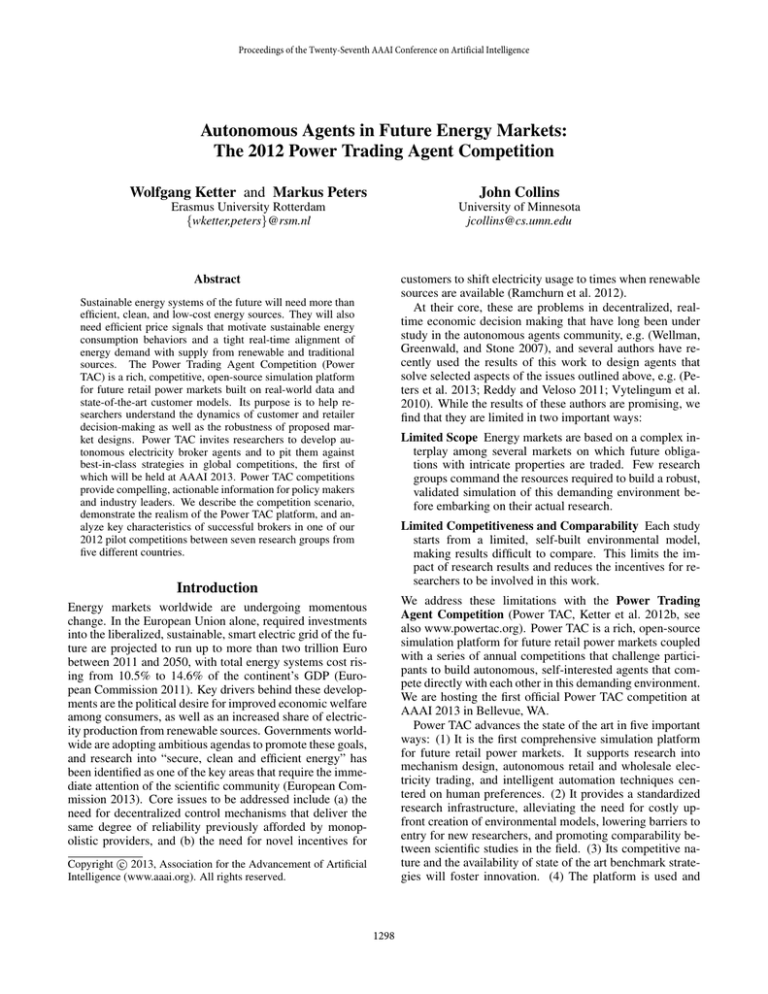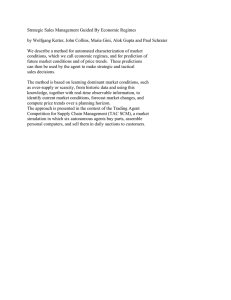
Proceedings of the Twenty-Seventh AAAI Conference on Artificial Intelligence
Autonomous Agents in Future Energy Markets:
The 2012 Power Trading Agent Competition
Wolfgang Ketter and Markus Peters
John Collins
Erasmus University Rotterdam
{wketter,peters}@rsm.nl
University of Minnesota
jcollins@cs.umn.edu
customers to shift electricity usage to times when renewable
sources are available (Ramchurn et al. 2012).
At their core, these are problems in decentralized, realtime economic decision making that have long been under
study in the autonomous agents community, e.g. (Wellman,
Greenwald, and Stone 2007), and several authors have recently used the results of this work to design agents that
solve selected aspects of the issues outlined above, e.g. (Peters et al. 2013; Reddy and Veloso 2011; Vytelingum et al.
2010). While the results of these authors are promising, we
find that they are limited in two important ways:
Abstract
Sustainable energy systems of the future will need more than
efficient, clean, and low-cost energy sources. They will also
need efficient price signals that motivate sustainable energy
consumption behaviors and a tight real-time alignment of
energy demand with supply from renewable and traditional
sources. The Power Trading Agent Competition (Power
TAC) is a rich, competitive, open-source simulation platform
for future retail power markets built on real-world data and
state-of-the-art customer models. Its purpose is to help researchers understand the dynamics of customer and retailer
decision-making as well as the robustness of proposed market designs. Power TAC invites researchers to develop autonomous electricity broker agents and to pit them against
best-in-class strategies in global competitions, the first of
which will be held at AAAI 2013. Power TAC competitions
provide compelling, actionable information for policy makers
and industry leaders. We describe the competition scenario,
demonstrate the realism of the Power TAC platform, and analyze key characteristics of successful brokers in one of our
2012 pilot competitions between seven research groups from
five different countries.
Limited Scope Energy markets are based on a complex interplay among several markets on which future obligations with intricate properties are traded. Few research
groups command the resources required to build a robust,
validated simulation of this demanding environment before embarking on their actual research.
Limited Competitiveness and Comparability Each study
starts from a limited, self-built environmental model,
making results difficult to compare. This limits the impact of research results and reduces the incentives for researchers to be involved in this work.
Introduction
We address these limitations with the Power Trading
Agent Competition (Power TAC, Ketter et al. 2012b, see
also www.powertac.org). Power TAC is a rich, open-source
simulation platform for future retail power markets coupled
with a series of annual competitions that challenge participants to build autonomous, self-interested agents that compete directly with each other in this demanding environment.
We are hosting the first official Power TAC competition at
AAAI 2013 in Bellevue, WA.
Power TAC advances the state of the art in five important
ways: (1) It is the first comprehensive simulation platform
for future retail power markets. It supports research into
mechanism design, autonomous retail and wholesale electricity trading, and intelligent automation techniques centered on human preferences. (2) It provides a standardized
research infrastructure, alleviating the need for costly upfront creation of environmental models, lowering barriers to
entry for new researchers, and promoting comparability between scientific studies in the field. (3) Its competitive nature and the availability of state of the art benchmark strategies will foster innovation. (4) The platform is used and
Energy markets worldwide are undergoing momentous
change. In the European Union alone, required investments
into the liberalized, sustainable, smart electric grid of the future are projected to run up to more than two trillion Euro
between 2011 and 2050, with total energy systems cost rising from 10.5% to 14.6% of the continent’s GDP (European Commission 2011). Key drivers behind these developments are the political desire for improved economic welfare
among consumers, as well as an increased share of electricity production from renewable sources. Governments worldwide are adopting ambitious agendas to promote these goals,
and research into “secure, clean and efficient energy” has
been identified as one of the key areas that require the immediate attention of the scientific community (European Commission 2013). Core issues to be addressed include (a) the
need for decentralized control mechanisms that deliver the
same degree of reliability previously afforded by monopolistic providers, and (b) the need for novel incentives for
c 2013, Association for the Advancement of Artificial
Copyright Intelligence (www.aaai.org). All rights reserved.
1298
The Power TAC Scenario
supported by a growing community of researchers and developers who contribute state-of-the-art models for all facets
of the environment, leading to continuous improvements in
the simulation’s realism and sophistication. And (5) Power
TAC advances beyond earlier Trading Agent Competitions
by providing extensive facilities for experiment management, data extraction, data visualization and analysis, and
mixed-mode games with human participation.
The paper is organized as follows. First, we give an
overview of related work in the agent, simulation and energy market literatures. Next, we describe the competition
scenario in some detail. And finally, we present a selection
of interesting insights based on one of our 2012 pilot tournaments.
The main elements of the Power TAC scenario are shown in
Figure 1. The scenario models a competitive retail power
market in a medium-sized city, in which consumers and
small-scale producers of electricity may choose among a
set of alternative electricity power providers, represented by
competing broker agents. The brokers are self-interested,
autonomous agents, built by individual research groups to
participate in the competition; the remainder of the scenario
is modeled by the Power TAC simulation platform. In the
real world, brokers could be energy retailers, commercial or
municipal utilities, or cooperatives.
In a tournament environment, simulations are run with
different numbers and combinations of broker agents, and
the agent that is most profitable over a range of scenarios is
the winner. Importantly, profit maximization does not preclude other social desiderata such as fairness, utilization of
renewables, or certain levels of electric vehicle market penetration. By properly setting the market’s economic mechanisms (Dash, Jennings, and Parkes 2003), market designers can create incentive structures that lead self-interested,
profit-maximizing brokers towards socially desirable outcomes. In a research environment, Power TAC may be
extended with experimental user-implemented mechanisms
that can then be subjected to broker competition to determine their effectiveness.
The simulation proceeds in a series of discrete timeslots,
each representing one hour in the simulation world. A typical tournament simulation runs approximately 60 days of
simulated time, although much longer simulations are possible. Time advances by one timeslot every five seconds,
so a simulation completes in about two hours. The actual
duration of the scenario is stochastic, to minimize the opportunity for brokers to exploit a predictable “end-of-game”
situation that, while it might win tournaments, has little research value or relationship to the real world.
Customers and Tariff Market Brokers interact through
a retail tariff market with customer models that simulate the
households and businesses of a small city. Some customers
are equipped with solar panels and windmills, producing as
well as consuming power. All customers are assumed to be
equipped with smart meters; consumption and production is
reported every hour. Many customer models also include
controllable capacities or demand-side management capabilities such as heat pumps or water heaters. These devices
can be remotely enabled or disabled to offset imbalances or
control costs, in exchange for lower rates.
Customer models exhibit sensitivity to weather conditions
(real-world weather reports and forecasts are used) and calendar factors such as day of week and hour of day. The
models also respond to price changes (Gottwalt et al. 2011)
and have a range of preferences over tariff terms. For example, some are willing to subscribe to variable-price tariffs if they have the opportunity to save by adjusting their
power usage, while others are willing to pay higher prices
for the simplicity of fixed-rate or very simple time-of-use
tariffs. This behavior is supported by real-world pilots with
dynamic pricing schemes (EPRI 2012).
Many customer models are capable of adaptive capacity
Related Work
Electricity markets are undergoing a transition from regulated monopolies to decentralized markets (Joskow 2008),
but so far the retailers in these markets are almost entirely
limited to purchasing power in the wholesale markets and
delivering it to their customers (Fleten and Pettersen 2005);
they have not had to deal with significant volumes of power
production among their customers. A critical unanswered
question is the extent to which self-interested behaviors of
market participants can effectively supplement hierarchical control of the physical infrastructure to balance supply and demand in such an environment. To answer this
important question we base our work on two major research streams, computational sustainability and competitive agent-based simulations.
The newly emerging computational sustainability field
studies the application of AI and other computational techniques to sustainability issues, and smart grids are one focus
area for that community. For example, Voice et al. (2011)
explore market-based strategies for controlling the use of
“home” and other micro energy storage. And Ermon et
al. (2012) formalize the problem of optimizing real-time energy management of multi-battery systems as a stochastic
planning problem, and propose a novel solution based on
a combination of optimization, machine learning and datamining techniques.
Among the many important open questions and research
challenges posed by a power grid with large numbers of active participants, e.g. (Ramchurn et al. 2012), only few can
be addressed by straightforward game-theoretic analysis (de
Weerdt, Ketter, and Collins 2011). The others are sufficiently complex that they cannot be effectively addressed
by formal methods. To address these more complex issues, a simulation-based technique known as Agent-based
Computational Economics (ACE, Tesfatsion 2002) has been
used to study electrical wholesale power markets, for example (Sun and Tesfatsion 2007; Reddy and Veloso 2011;
Peters et al. 2013). Like other Trading Agent Competition
scenarios (Ketter and Symeonidis 2012), Power TAC extends the ACE paradigm by creating a rich economic simulation and inviting research teams to develop their own software agents to play the role of power retailers in the simulation, and to enter them in annual competitions.
1299
Figure 1: Main elements of the Power TAC scenario. Brokers are the competitors; markets, customers, energy suppliers, and
distribution utility are modeled by the Power TAC simulation platform.
management, allowing them to evaluate various possibilities
for capacity shifting and choose amongst the ones best suited
to the applicable tariff rates, while also considering the potential choices of other customers that may be on the same
tariff (Reddy and Veloso 2012).
Tariff contracts may include usage-based and per-day
charges, fixed and varying prices for both consumption and
production of energy, rates that apply only above a specified usage threshold, signup bonuses, and early-withdrawal
penalties. Separate contracts may be offered for charging
electric vehicles, which could limit charging during highdemand periods, or even offer to pay customers for feeding
energy back into the grid at certain times. Variable prices
may follow a fixed schedule (day/night pricing, for example), or they may be fully dynamic, possibly with specified
advance notice of price changes.
Wholesale Market and Generating Companies Brokers
may buy and sell energy from retail customers, and they
may buy and sell energy for future delivery in a wholesale market, which is modeled on real-world markets such
as the European and North American day-ahead wholesale
power markets. At any given time, brokers may place orders
in the wholesale market to buy or sell power in 24 separate auctions, the first for delivery in the following timeslot,
and the last 24 hours in the future. On the supply side, the
Power TAC platform includes large producers (or Gencos)
that simulate utility-scale power suppliers who sell their output through the wholesale market. These suppliers represent
different price points and lead-time requirements, e.g. fossil
and nuclear power plants, gas turbines, and wind parks.
Distribution Utility The Distribution Utility (DU) models a regulated monopoly or government entity that owns and
operates the physical facilities (distribution lines, transformers, etc.) and is responsible for real-time balancing of supply
and demand within the distribution network. It does this primarily by operating in the regulating market, the real-time
facet of the wholesale market, and by exercising demand and
supply controls provided by brokers. The associated costs
are allocated to the brokers responsible for the imbalance. In
the real world, this balancing responsibility is typically han-
dled higher in the grid hierarchy, by the Independent System
Operator (ISO, North America) or Transmission System Operator (TSO, Europe); the simulation implements a generalization of proposals to move some balancing responsibility
to the distribution level (Strbac 2008).
Power TAC is a market simulation. It abstracts away
most technical considerations, such as power factor and distribution losses, that arise from non-ideal behaviors of the
real power infrastructure. As long as volumes of delivered
power do not approach physical constraints, we can treat
most such phenomena as discounts, and fold them into the
market structures. For example, distribution losses can be
roughly accounted for by charging brokers a per-kilowatthour fee for delivering power to their customers.
Brokers Brokers develop customer portfolios by offering
tariff contracts to a population of anonymous residential and
business customers, and by negotiating individual contracts
with larger customers (such as major manufacturing facilities, or greenhouse complexes with many Combined Heat
and Power (CHP) units).1 Because controllable capacities
can reduce costs significantly, brokers can offer special tariffs for them, and then make offers to the DU for the right
to exercise them to reduce imbalances. Given a portfolio of
customers, brokers compete with each other in the wholesale market to minimize the cost of power they deliver to
their consuming customers, and to maximize the value of
power delivered to them by their producing customers.
Insights from the 2012 Pilot Competitions
We have hosted several pilot competitions on the Power
TAC platform, including competitions at IJCAI 2011 in
Barcelona, at AAMAS 2012 in Valencia, and at IEEE SGTEP 2012 in Nuremberg.2 Teams from Croatia, Germany,
Greece, Korea, Mexico, Netherlands, UK, and the US entered brokers in these tournaments, providing us with a full1
The negotiation feature was not implemented for the 2012
tournaments.
2
International Joint Conference on Artificial Intelligence, Autonomous Agents and Multi-Agent Systems, and IEEE Conference
on Smart Grid Technology, Economics, and Policies, respectively
1300
Research Group
Aston University Birmingham
University of Zagreb
Erasmus University Rotterdam
Aristotle University Thessaloniki
University of Texas at El Paso
University of Southhampton
University of Texas at Austin
13
9
UTest
11
16
SotonPower
13
17
MinerTA
Broker
Broker
AstonTAC
CrocodileAgent
LARGEpower
Mertacor
MinerTA
SotonPower
UTest
Table 1: Participants in the 2012 Nuremberg pilot competition
11
11
13
13
Uncertain
Mertacor
Certain
LARGEpower
scale validation of Power TAC, and broker developers with
opportunities to evaluate their strategies.
A credible simulation must emulate interesting real-world
phenomena, while abstracting away details that are unlikely
to contribute to the phenomena of interest. As part of our
validation, we expected several characteristic phenomena
to emerge from interaction between brokers and the Power
TAC platform. These included:
32
19
default broker
3
10
AstonTAC
3
5
Game Size
Competitiveness Broker performance should depend on
broker strategies, not on random draws. We expected consistent, discernible performance differences between high
and low performers in the field.
Figure 2: Average profit share of brokers in the Nuremberg
2012 pilot competition. Certainty is computed as the inverse
sample standard deviation. Small numbers indicate the number of games on which a data point is based. The default broker is an unsophisticated strategy provided by Power TAC
itself and models the incumbent monopoly.
Resilience to Competition We expected the best strategies
to keep their competitive edge under competition from additional brokers.
Balancedness We expected that the best strategies would
perform competitively in all three markets: retail, wholesale, and regulating market.
Figure 3 shows the strategic positions of brokers in the retail market for electricity consumption.4 As expected, there
is a clear relationship between the price level offered on
electricity tariffs and the share of customer demand served.
Mertacor, Aston TAC, and UTest are high volume players, offering competitive rates in exchange for significant
shares of the retail market. Mertacor, in particular, consistently captures the majority of the market at extremely
low prices which cut into its own margins (see Figure 2).
SotonPower and AstonTAC are interesting in that their successes appear to hinge on fundamentally different causes:
while Aston TAC aims to attract large volumes in the retail market, SotonPower’s success is apparently based on a
more moderated combination of larger markups and other
factors discussed below. Importantly, the retail rates offered
are typically less than half the cost of the rates offered by the
incumbent monopoly (default broker), which illustrates the
benefits of competitive retail pricing to customers. Somewhat surprisingly, we find no discernible variation in retail
markups over different game sizes. This suggests that the
early-stage brokers studied here are not yet fully exploiting
their strategic options.
To offset the (expected) consumption of their retail customers, brokers must acquire future supply commitments in
Economic Realism We expected to re-discover a number
of fundamental economic truths in the competition results: prices should correlate with demand, wholesale
prices should be higher for shorter leadtimes, and profit
margins should fall with increasing competition.
We analyzed 51 games from the Nuremberg 2012 pilot
competition.3 Our analyses give insights into the key success factors behind high-performing broker strategies, and
suggest important areas of future work for broker developers. Table 1 lists the participating brokers.
To get a sense of overall performance, we first analyzed
broker profit shares – the percentage of each broker’s profit
in all profits made during a game (see Figure 2). Interestingly, we find pronounced differences in terms of profit
share magnitude, certainty, and resilience to competition.
AstonTAC, for example, does well on all three counts, with
profits that are high on average, stable over different games,
and relatively unaffected by the additional competition introduced in 5-player games. Mertacor and LARGEpower,
on the other hand, play strategies that perform well in some
cases, but that are not as consistent. To understand the reasons for these differences we analyzed the brokers’ actions
in Power TAC’s three principal markets: retail, wholesale,
and regulating market.
that were affected by technical flaws of the beta.
4
Only AstonTAC and UTest also purchased power in the retail
market during the games that we analyzed; volumes were small in
relation to wholesale market activities.
3
The Nuremberg competition used the most recent beta version
of the Power TAC platform; for this analysis, we excluded games
1301
be worthwhile for a broker to risk an imbalance if it has the
opposite sign from the overall imbalance. This relationship
makes the regulating market an interesting strategic element
for brokers.
As expected, the figure shows no simple connection between the level of imbalance and the corresponding reward
or penalty to the broker. Some general trends, however, can
be observed: undersupply (lower half of the figure) generally leads to higher penalties than the rewards afforded by
oversupply (upper half of the graph). This is reflective of
the asymmetric balancing mechanism employed in Power
TAC (de Weerdt, Ketter, and Collins 2011), and it illustrates
the difficulties in explicitly using the balancing market as
part of a strategy. AstonTAC, Mertacor, and to a lesser extent LARGEpower, are mostly well-balanced. They sometimes do incur sizable penalties, however, as a result of small
errors on large volumes. MinerTA and SotonPower generally make larger mistakes on smaller volumes, and these
mistakes are more favorably distributed between over- and
undersupply, leading to smaller overall balancing penalties
or even to rewards in the balancing market. UTest makes
large, systematic errors on large volumes, leading to hefty
penalties.
2xAvg
Price Level (Consumption)
default broker
MinerTA
Avg
SotonPower
LARGEpower
AstonTAC
UTest
Mertacor
Zero
0%
50%
100%
Average Retail Market Share (Consumption)
Figure 3: Retail market position of participating strategies.
Lighter coloring indicates higher market share uncertainty.
Log Balancing Market Profit [Money Units]
the wholesale market. Figure 4 illustrates brokers’ strategic
positions in this market. SotonPower’s low-volume strategy,
likely combined with high forecasting accuracy, allows it to
cover its electricity needs at extremely low prices, which explains at least part of its overall success. The relatively weak
brokers LARGEpower, Mertacor, and UTest are, conversely,
paying prices that are up to 1.6 times above market average.
Note that this is not solely a consequence of large volumes
and the corresponding need to invoke marginal, high-cost
providers of electricity. AstonTAC, for example, acquires
larger amounts of electricity than LARGEpower at lower
prices on average, suggesting better timing of wholesale purchases or smarter use of bid prices. Mertacor pays the most
for wholesale power; together with its low-cost tariffs, this
largely explains its relatively weak performance.
Mertacor
Broker
AstonTAC
LARGEpower
Mertacor
MinerTA
SotonPower
UTest
10
0
Total Distribution
Volume [kWh]
0.0e+00
2.5e+07
5.0e+07
7.5e+07
1.0e+08
10
0.1
1.5xAvg
1.0
10.0
Price Level (Purchase)
Log Unbalancedness
UTest
Figure 5: Balancing market positions. Each point represents one broker/game combination; larger symbols indicate
higher overall volumes. Notice the log-log scaling.
LARGEpower
Avg
default broker
SotonPower
MinerTA
AstonTAC
To gain a deeper understanding of the dynamics of these
games, we finally looked at results in individual games.
These analyses shed further light on broker performance differences, and they suggest interesting questions for future
research. For the sake of brevity, we discuss only selected
examples here. Figure 6 shows the relationship between
purchase volume and price in the wholesale market for two
complete example games. Interestingly, two very different
patterns emerge: the game in the left panel is characterized
by the expected upward sloping relationship between volume and price. As higher-cost providers of electricity need
to be activated to cover demand, prices rise. Whereas the
game in the right panel shows a general upward tendency,
it also shows pronounced signs of economic regime (Ketter et al. 2012a) transitions (including an “outlier regime” in
the upper right-hand corner of the panel), and of start-game
effects (lighter dots on the lower left) as brokers adapt to
0.5xAvg
0%
50%
100%
Average Wholesale Market Share (Purchase)
Figure 4: Wholesale market position of participating strategies. Lighter coloring indicates higher market share uncertainty.
We next looked at the market for balancing power (regulating market, see Figure 5). This market is implicit in that
residual imbalance between consumption and production is
automatically offset by the DU in real-time. The penalties
(or rewards) that a broker incurs in the process are, however,
dependent on the overall imbalance on the grid at that instant, as well as on their own imbalances. As a result, it can
1302
the market. From a theoretical perspective, it is interesting
to consider the properties of the participating strategies that
lead to this behavior. Power TAC enables the replay of individual games to support this type of research.
e493: AstonTAC,default broker,LARGEpower,Mertacor,SotonPower
game567: default broker,MinerTA,UTest
Purchase
Volume [MWh]
60000
80
40000
Price
20000
game545: default broker,MinerTA,SotonPower game577: default broker,LARGEpower,SotonPower
60
60
Broker
AstonTAC
LARGEpower
Mertacor
MinerTA
SotonPower
UTest
40
75
Average Price
50
Time
1500
40
20
1000
50
1
500
30
12
24 1
12
24
Leadtime [hours]
0
20
Figure 7: Leadtime effects in the wholesale market; left
panel: AstonTAC vs. default broker vs. LARGEpower vs.
Mertacor vs. SotonPower; right panel: default broker vs.
MinerTA vs. UTest
25
0
25
50
75
100
0
30
60
90
Wholesale Purchases [MWh]
Figure 6: Wholesale prices as a function of volume. Each
dot represents the clearing price for one timeslot, lighter dots
are earlier timeslots. Left: default broker vs. MinerTA vs.
SotonPower; right: default broker vs. LARGEpower vs. SotonPower
The annual competition model, along with availability of the
platform and a set of working agent implementations, has
been an effective driver of research activity in domains as
diverse as robot soccer, disaster response, and supply-chain
management.
The preliminary analyses we presented are evidence of the
realistic macro-level behavior emerging from broker interaction with Power TAC, and of significant performance differences between different approaches to retail electricity trading. Once the participating strategies are fully developed,
tools like empirical game theory (Jordan, Kiekintveld, and
Wellman 2007) can be leveraged to generate compelling, actionable insights into novel technologies and public policies
for future sustainable energy systems.
The Power TAC platform, including the simulator, broker
agent framework, log analyzer, and tournament manager, is
an open-source project, designed and documented to be accessible to advanced students. Access to the software and
documentation, along with a repository of broker agent implementations, will be maintained through the powertac.org
website. We look forward to many years of vigorous competition and high-impact research results.
While Figure 6 suggests a somewhat homogenous wholesale market, it is worth noting that wholesale bidding in
Power TAC is actually highly complex. In addition to deciding the optimal bid price and volume, a broker also needs
to factor the optimal leadtime into its decision. Recall that
for any given timeslot in which electricity is needed, there
are 24 separate but interrelated auctions ranging from 1 to
24 hours in advance. Figure 7 shows the impact of leadtime
on prices for two selected games. Both panels show the general downward-sloping price trend for increasing leadtimes
that economic theory would suggest. However, there are irregularities in these graphs that underline the importance of
reasoning about leadtimes and order limits. First, the graphs
explain the high prices that Mertacor and UTest are paying
in the wholesale market. In the left panel, Mertacor covered all its electricity demand in the 2-hour-ahead auction
at prices that are close to double the prices of longer leadtimes. In the process, it drives up prices for AstonTAC and
LARGEpower, while SotonPower controls its exposure to
this effect through limit orders. An analogous observation
holds true for UTest in the right panel. LARGEpower (left
panel) placed all its orders as market orders. This leads to
relatively good balancing performance, as only forecasting
error and no uncertainty in order filling impact its results,
but it is also subject to unpredictable fluctuations in wholesale prices that will hamper its risk management efforts.
Acknowledgements
Thanks to the Power TAC developers at Minnesota, Aristotle
in Thessaloniki, Zagreb, CMU, and Erasmus in Rotterdam,
and to all the teams who saw the promise of Power TAC
and have been willing to invest in broker development for a
rapidly evolving platform.
References
Conclusions and Future Work
Dash, R.; Jennings, N.; and Parkes, D.
2003.
Computational-mechanism design: A call to arms. Intelligent Systems, IEEE 18(6):40–47.
de Weerdt, M.; Ketter, W.; and Collins, J. 2011. Pricing mechanism for real-time balancing in regional electricity
markets. In Workshop on Trading Agent Design and Analy-
Our energy-hungry civilization must somehow adapt itself
to the availability of renewable sources. This will require a
combination of new technology and public policy that works
with real people and institutions. The Power TAC project
intends to contribute by providing a robust research platform
for testing market-based approaches to energy sustainability.
1303
Sun, J., and Tesfatsion, L. 2007. Dynamic testing of wholesale power market designs: An open-source agent-based
framework. Computational Economics 30(3):291–327.
Tesfatsion, L. 2002. Agent-based computational economics:
Growing economies from the bottom up. Artificial Life
8(1):55–82.
Voice, T. D.; Vytelingum, P.; Ramchurn, S. D.; Rogers, A.;
and Jennings, N. 2011. Decentralised control of microstorage in the smart grid. In AAAI Conference on Artificial
Intelligence, 1421–1427.
Vytelingum, P.; Ramchurn, S.; Voice, T.; Rogers, A.; and
Jennings, N. 2010. Trading agents for the smart electricity grid. In Proceedings of the 9th International Conference on Autonomous Agents and Multiagent Systems: volume 1-Volume 1, 897–904. International Foundation for Autonomous Agents and Multiagent Systems.
Wellman, M. P.; Greenwald, A.; and Stone, P. 2007. Autonomous Bidding Agents. MIT Press.
sis at the Twenty-second Int’l Joint Conf. on Artificial Intelligence.
EPRI. 2012. Electric Power Research Institute - Understanding electric utility customers - Summary report.
Ermon, S.; Xue, Y.; Gomes, C.; and Selman, B. 2012.
Learning policies for battery usage optimization in electric
vehicles. Machine Learning and Knowledge Discovery in
Databases 195–210.
European Commission. 2011. Communication: Energy
Roadmap 2050.
European Commission. 2013. Horizon 2020 Programme.
Fleten, S.-E., and Pettersen, E. 2005. Constructing bidding
curves for a price-taking retailer in the Norwegian electricity
market. IEEE Transactions on Power Systems 20(2):701 –
708.
Gottwalt, S.; Ketter, W.; Block, C.; Collins, J.; and Weinhardt, C. 2011. Demand side management - a simulation
of household behavior under variable prices. Energy Policy
39:8163–8174.
Jordan, P. R.; Kiekintveld, C.; and Wellman, M. P. 2007.
Empirical game-theoretic analysis of the TAC supply chain
game. In Seventh International Conference on Autonomous
Agents and Multi-Agent Systems, 1188–1195.
Joskow, P. L. 2008. Lessons learned from electricity market
liberalization. The Energy Journal 29(2):9–42.
Ketter, W., and Symeonidis, A. 2012. Competitive benchmarking: Lessons learned from the Trading Agent Competition. AI Magazine 33(1).
Ketter, W.; Collins, J.; Gini, M.; Gupta, A.; and Schrater, P.
2012a. Real-time tactical and strategic sales management for
intelligent agents guided by economic regimes. Information
Systems Research 23:1263–1283.
Ketter, W.; Collins, J.; Reddy, P.; and de Weerdt, M. 2012b.
The 2012 Power Trading Agent Competition. Technical Report ERS-2012-010-LIS, RSM Erasmus University, Rotterdam, The Netherlands.
Peters, M.; Ketter, W.; Saar-Tsechansky, M.; and Collins, J.
2013. A reinforcement-learning approach to autonomous
decision-making in smart electricity markets. Machine
Learning Journal Special Issue on ECML-PKDD 2012.
Forthcoming.
Ramchurn, S.; Vytelingum, P.; Rogers, A.; and Jennings,
N. 2012. Putting the ”smarts” into the smart grid: A grand
challenge for artificial intelligence. Communications of the
ACM 55(4):86–07.
Reddy, P., and Veloso, M. 2011. Learned Behaviors of Multiple Autonomous Agents in Smart Grid Markets. In Proceedings of the Twenty-Fifth AAAI Conference on Artificial
Intelligence (AAAI-11).
Reddy, P., and Veloso, M. 2012. Factored Models for Multiscale Decision Making in Smart Grid Customers. In Proceedings of the Twenty-Sixth AAAI Conference on Artificial
Intelligence (AAAI-12).
Strbac, G. 2008. Demand side management: Benefits and
challenges. Energy Policy 36(12):4419–4426.
1304





